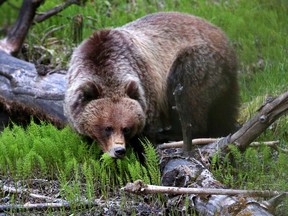‘Respect closures like this. “There are reasons why they have been implemented, and it is for the safety of wildlife and also people.”

Article content
Hungry grizzly bears and photo-seeking visitors have led to the introduction of a no-go zone for a section of Highway 1A in Banff National Park, and violators could face hefty fines.
As of Friday of last week, Parks Canada issued the no-stop zone for a 320-metre stretch of Highway 1A. west of Baker Creek and east of Protection Mountain Campground. In the affected area there are signs indicating that stopping is prohibited.
Advertisement 2
Article content
Article content
Violators could face mandatory court appearances and be fined between $115 and $25,000.
The zone, a temporary restriction, was implemented because two large male grizzly bears frequented the area, sparking visitor interest generated by social media posts, said Charlie McLellan, acting wildlife ecologist at the national parks. from Banff, Yoho and Kootenay.
“The number of people visiting the site and the location have made it potentially dangerous for both bears and people.”
He noted that the location is adjacent to train tracks, making it less ideal for parking in the area, and also raising concerns that bears fleeing from oncoming trains could run toward people stopped in the roadway. .
Parks Canada staff were seeing an increased presence of visitors, he said.
“Things seemed to escalate and it was determined that it really wasn’t a safe viewing opportunity for people,” McLellan said. “People were sitting there for hours and we’re getting dozens of vehicles (stopped).”
Also influencing the restriction was the possibility of the bears becoming more accustomed to people and vehicles.
Article content
Advertisement 3
Article content
McLellan said the bears are most likely in the area because of the grain that accumulated over the winter around the railroad tracks.
“That’s attractive to bears this time of year because there really aren’t many other rich food sources in early spring.”
Although it’s unclear exactly when the no-go zone will be lifted, it’s likely tied to bear activity in the area as other food sources become available, McLellan said.
“We never like to disrupt people’s visits and we respect that many visitors come to see bears. When it is safe to do so, we like to provide those opportunities.”
Outside the prohibited zone, McLellan said your viewing guidelines It is recommended to travel in groups of four or more, stay in a vehicle whenever possible, maintain a distance of 100 meters, and carry bear spray.
“Respect closures like this. “There are reasons why they have been implemented, and it is for the safety of wildlife and also people.”
Recommended by Editorial
-

Banff bear attack revitalizes bear protection policy debate
-

Photographer Meets ‘The Boss’, Bow Valley’s Toughest Grizzly Bear
Advertisement 4
Article content
‘These bears need peace and quiet to feed undisturbed’
Nick de Ruyter, director of the WildSmart program at Canmore’s Bow Valley Biosphere Institute, agreed with Parks Canada’s move.
“Non-stop zones are very good and very important,” he said.
With mostly male grizzly bears and black bears coming out of their dens this spring, de Ruyter said they are focused on eating this time of year.
“I really think they need to have more no-stop zones, or closed areas, because these bears need peace and quiet to feed undisturbed.”
“When you have hundreds or thousands of people running around and trying to take pictures, they get stressed and it could affect how they eat and how they survive the next season,” de Ruyter said.
He said that in places where stopping is allowed, visitors should think about what is best for the animal, most importantly maintaining a distance of about 10 school bus lengths.
“You don’t have to get close, you can take pictures from 100 meters away and still get a good shot.”
He The WildSmart program has resources with information about bears and other wildlife, with the goal of helping teach the community how to safely coexist with wildlife and reduce negative human-wildlife interactions.
Article content


